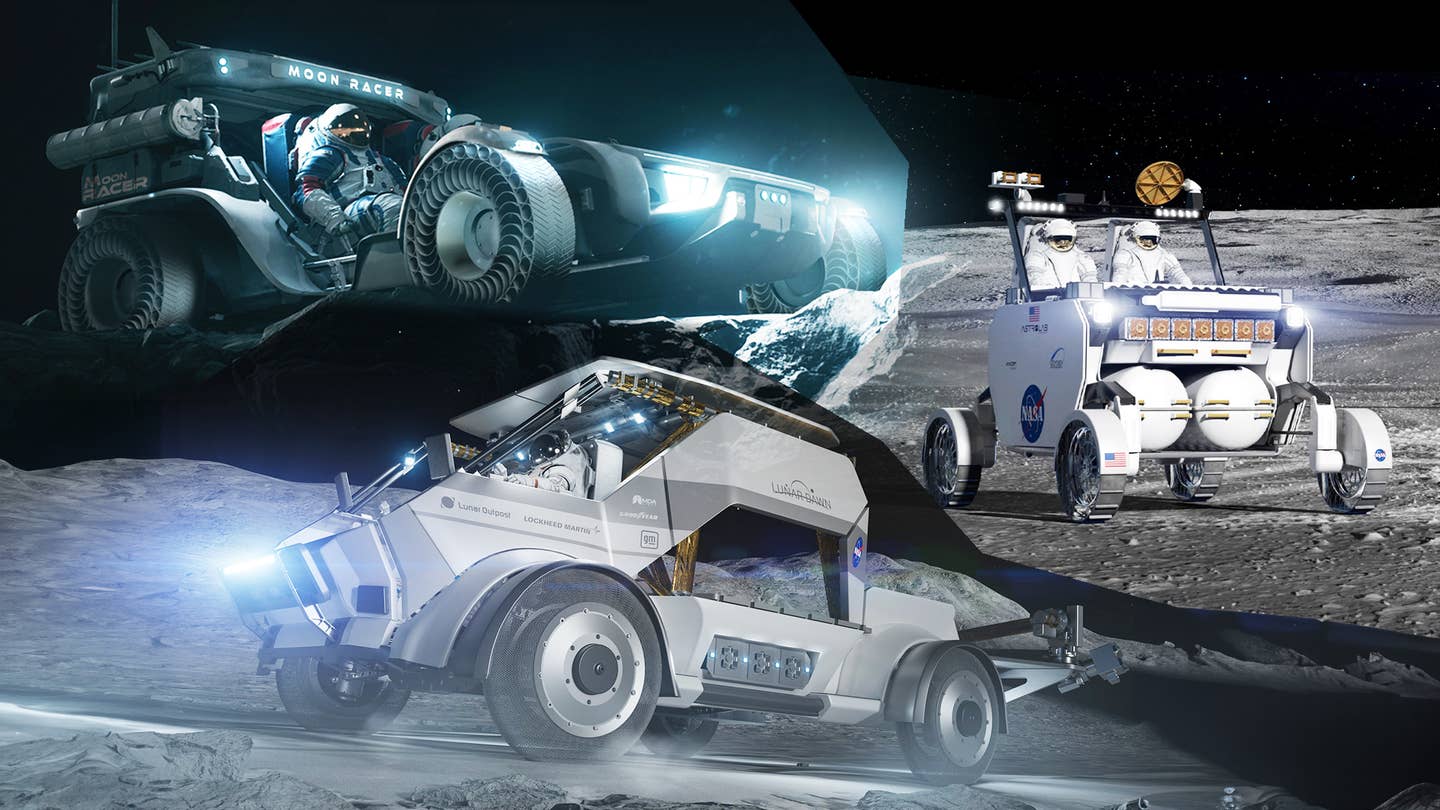NASA’s New Car: 3 Lunar Rover Finalists Picked for 2030 Moon Mission
No, NASCAR’s bid isn’t one of them.

NASA just took a major step toward its next manned mission to the moon. After a long process, America’s space agency has selected three finalists for designing the next-generation lunar rover: Intuitive Machines, Lunar Outpost, and Venturi Astrolab, all of which are backed by some huge names. NASA’s first honest-to-goodness space car in more than 50 years will support the Artemis missions, an ongoing program of manned and unmanned lunar missions that began with the uncrewed Artemis I in 2022. NASA plans to send astronauts and their new whip to the moon in 2030.
The chance to build America's next Space Car drew interest from some surprising sources. Even NASCAR tried to grab a piece, in partnership with tech firm Leidos. The winners are no less eccentric. Venturi's version should at least be quick: The company is best known for exotic, high-performance EVs, notably developing the body for Formula E racers. Lunar Outpost has GM and Goodyear on side, so expect lunar drag races. Intuitive Machines' core offer is "what if Uber, but space?", running a rideshare program allowing multiple private-sector customers to pack their payloads onto the same rocket.
The rover teams may not be conventional government contractors, but the Lunar Transport Vehicle (LTV) isn't a conventional project. Since the end of the Apollo missions, lunar rovers have always been autonomous, closer to the Mars rovers than actual transport: robot sensor platforms that run independently and send data home. NASA needs more. The LTV vision is more like a very, very off-road four-wheeler, tough and suited to a variety of terrain. It will also have a degree of autonomous driving -- how much depends on the designer -- and function as a mobile science station as well as transport, empowering astronauts to travel farther and carry out more complex missions than ever before. The LTV will be a vital part of the Artemis missions until at least 2039.
Since the only other manned rover was Apollo's battery-powered dune buggy, which last touched moondust in 1972, designers have a blank slate. They've gone big. Venturi's FLEX - that's Flexible Logistics and Exploration - can function both as an autonomous science platform like the Mars rovers and a working vehicle capable of transporting two astronauts. It's still got Venturi flair, too: the bespoke batteries come from Monaco and the "hyper-deformable wheels" have taut cables instead of spokes to absorb impact on lunar terrain.
The Lunar Outpost design, called "Lunar Dawn," decided bigger was better. Lunar Dawn is a heavy four-wheeler built for maximum toughness and minimal maintenance. Intuitive Machines has been less forthcoming about their design. In 2023, the company announced plans to put the Japanese unmanned rover Yaoki on the moon's south pole, but as yet there are no further details and no statement on whether Yaoki will influence the company's own design.
The LTV is a big job and the pay is commensurate. NASA expects to spend $4.6 billion on the project. Per NASA's RFP, the three finalists will complete a year-long study, submit a design for NASA's approval, then carry out a comprehensive demonstration of their builds. In the end, NASA will award a contract to just one company, though it expects to issue other work orders for issues that arise during the development process.
The finalists are already building teams to do the job. Per press releases, Lunar Outpost will partner with GM, Goodyear, Lockheed, and MDA Space to design their prototype. Intuitive Machines reports a similar list of luminaries, including Boeing, Michelin, and Northrop Grumman. Venturi intends to work with Axiom Space and Odyssey Space Research. Many partner organizations have serious prior in aerospace engineering. Companies like Northrop Grumman have been working with the U.S. space program since its founding, and GM has been part of the lunar rover conversation for years.
The Lunar Dawn rover is set to blast off with the Artemis V mission. As yet, there's no definite launch date, but the schedule for earlier Artemis missions suggests Artemis V will take to the sky sometime in the late 2020s.
